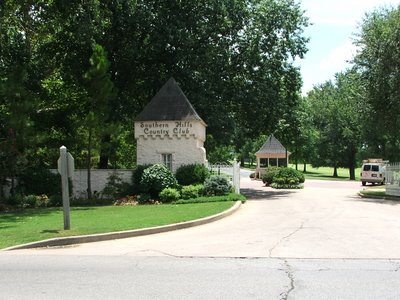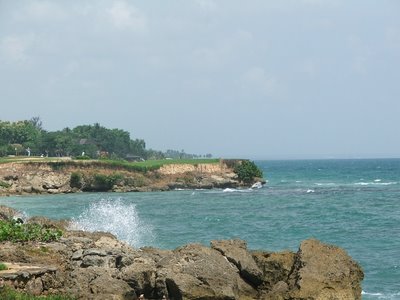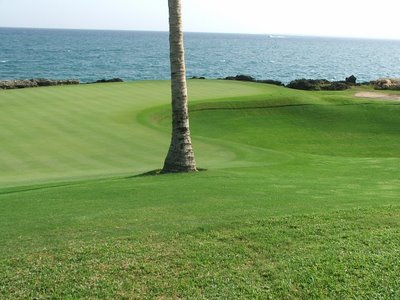Minggu, 27 Agustus 2006
Golf Gods Strike Tiger, But He Still Won
They did so Saturday during the 3rd round of the Bridgestone Invitational. After taking a commanding lead, Tiger turned into your average Weekend Warrior golf hack. Tiger succumbed to the God of Bogeys and recorded four consecutive bogeys, his longest such streak in nearly 10 years. All of a sudden Tiger's comfortable two-shot lead disintegrated and left him five shots behind the leader. Dave Pelz was smiling. Phil was smiling too, but when is he not?
But knocking Tiger's A-game down his C-game is still better than most PGA Pros' A-games. In the end, it was barely enough to get by a feisty Stewart Cink and chalk up career PGA Tour win number 52. Simply amazing.
With all of Tiger's success after two major swing overhauls, I'm beginning to think that Tiger could win if he adopted Charles Barkley's swing:
However, I still think that Tiger's swing under Butch Harmon's watch was still the best. Fortunately, we can still see what it looked like by watching Adam Scott, the White Tiger (updated with video).
Southern Hills and Prairie Dunes

What do Prairie Dunes Country Club (ranked #23 in the world) and Southern Hills Country Club (ranked #41 in the world) have in common? Both were designed by Perry Maxwell during the depression era and both are located in the dust bowl region of the United States. Prairie Dunes in the flatlands of Kansas and Southern Hills in Tulsa Oklahoma. Maxwell must have been at the height of his creative genius in 1935, when both were built.
Perry Maxwell

The first green at Prairie Dunes
Prairie Dunes was the Sand Hills of its day - that is, the depression era. It was built on an ancient salt sea near the town of Hutchinson, Kansas. Hutchinson's claim to fame was as a salt mining town. I found Hutchinson, Kansas to be a very depressing town. The vistas in the city consist of big ugly cement grain elevators. The downtown is a rundown, boarded up and dying group of old traditional stores. Before there was either salt mining or golf in Hutchinson, there were prisons, which date back to 1885. The main employers in town are the two prisons. The high security penitentiary defines the western border of the town and the lower security reformatory defines the eastern border. Of Hutchinson's 40,000 residents, 1,800 sleep in cell blocks. Sadly, like a lot of towns in America today, the most vibrant part of town is the edge where big box chains have invaded - Wal-Mart and Home Depot interspersed with IHOP pancake houses and Applebee's fast food restaurants. In many cities, hotels where the door to your room is directly from the parking lot and charge $69, are for hire by the hour.
In Hutchinson, the premier hotel in town, The Grand Prairie, charges $69 per night including breakfast. Certainly, a true bargain on the quest to play the top 100. The hotel, which we were worried about, actually worked out fine. It was clean and we were able to have drinks with two members we didn't know who we met at the bar, who gave us some insight into the greatness of the course. They were so nice that one member actually drove back to his house and came back to give us a copy of the USGA Senior Open program that was recently held at Prairie Dunes so we could appreciate the holes. While the town was depressing, the golf course certainly was not.
The scorecard says the course is a Perry Maxwell Masterpiece and I would have to fully agree. Ben Crenshaw, the designer of Sand Hills has said of Prairie Dunes "this is golf on the first order." Jack Nicklaus called it the Pine Valley of the West. I was lucky to play Prairie Dunes on a nice day and with a two club wind, which is enough for you to get a good feel for how the course should play, without being overbearing. As compared to Southern Hills, the greens, while not large by conventional standards, are not quite as small. The greens almost all have at least two tiers so placement of your ball on the correct spot on the green is of paramount importance.
I can see the similarities in the two Perry Maxwell designs - lots of sharp doglegs and intelligent use of the terrain, particularly the uphill shots required into the greens. In almost no instance on the course is your shot to the green a level approach. Maxwell also took a minimalist approach to fairway bunkers which works out very well since the rough is quite penal and you don't need additional hazards. Joe Dye, former head of the U.S.G.A. once wrote that "a golf logo to symbolize the course would be a golfer standing deep in the rough looking for his ball." We hit into the rough a couple of times in our group and each time it was a lost ball.
Two holes in particular are truly world class - the 8th hole, which is the #1 handicap hole is a 430 yard dogleg right that plays uphill all the way. The feature that makes it unique are the massive ripples in the fairway that look like waves coming in from the ocean. You can see in the pictures above, with a golfer present for perspective, how severe the slope and rippling both are.
The 12th hole (pictured above) is a 390 yard par four and is also one of the best I've had the privilege to play. You hit your tee shot from an elevated tee to the fairway below. The strategy of the hole comes from two large cottonwood trees that are on either side of the fairway about 75 yards from the hole. These force you to either lay well back off the tee and then hit a high shot over them to the green or more typically to have to hit a low trajectory shot to a well protected and difficult green. It's too bad you don't see more holes like this. I guess this is because most golfers feel it is their right to have a clear shot at the green if they have a good drive in the fairway and architects generally agree. But I think this hole proves that there are exceptions (a very good exception in this case) to every rule. Also, in a stroke of brilliance, a really good drive hit precisely long enough and between the trees favoring the left side leaves an easy wedge shot between the trees. Great risk/reward!
I did some reading on Prairie Dunes prior to traveling to the course and was expecting the 10th hole to be a really exceptional hole. Maxwell himself said of the par three 10th hole - "this is the most beautiful par three ever constructed. Cypress Point, St. Andrews, Pinehurst and Augusta have nothing to compare with it." I don't agree with Mr. Maxwell on this point. The 10th is a fine golf hole but I actually thought that the 2nd (pictured below) and 4th hole, also par threes, were as good or better.

In an unfortunate incident at Prairie Dunes, on the 9th green the threesome riding behind us hit up on us while our threesome was on the green. Not just one golfer - all three players. For my regular readers you will know that I play fast - in fact we were playing at a good clip and most of the time were waiting for a twosome in front of us to move before we could hit. Being guests to the club we didn't make a big deal out of it. We let the assholes play through on the 10th tee. I'm not sure whether the three were just angry at living in a two-prison town or whether they had too much to drink, but this kind of behavior is not acceptable. God forbid they hit someone in the eye or the head with the ball - hitting up on people is a very bad idea. We mentioned the incident to the cart girl who was roaming the course with beverages. She said that this particular group has a reputation for hitting up on people while drinking. This is a commercial for not having a beverage cart circulate on a golf course, especially since this course had water on almost every tee box anyway. I'm sure most of the members of Prairie Dunes are delightful people but they should not tolerate this type of bad behavior. The cart girl apologized to us as did the assistant-pro whom she told as well. I don't see a place in golf for morons like these, though. If you would like to play through, all you have to do is ask. I hope the course has a good liability insurance policy in place while these guys remain members. Oh, and in what I think is complete poetic justice, to just prove the lack of intelligence of these fools, one drove out of the course after the round in a Hummer. In any event, I don't want to end on a negative, the place is great.
Kudos to the superintendents and green staff at both courses, which were in great condition. Prairie Dunes is a private club and access to play the course is through a member. You can visit their website for more history. The same for Southern Hills which will play host to the 2007 PGA Championship.
Minggu, 20 Agustus 2006
Dave Pelz Was Wrong for Once
Dave Pelz, the well-known short-game authority and mad scientist of golf, is one golf instructor that I respect tremendously.
 As a former NASA engineer, Pelz supports his teachings with solid scientific research. It's not uncommon for him to have reams of data to back up his findings. For example, Pelz provided the statistical data that proves that putts rolled at a speed to exactly 17 inches beyond the hole have a higher probability rate of going in than putts hit at any other speed. He also conducted experiments that answered the age-old question, "Should you leave the flagstick in the hole or pull it out?" When Pelz says something about golf, you might as well just accept it as fact.
As a former NASA engineer, Pelz supports his teachings with solid scientific research. It's not uncommon for him to have reams of data to back up his findings. For example, Pelz provided the statistical data that proves that putts rolled at a speed to exactly 17 inches beyond the hole have a higher probability rate of going in than putts hit at any other speed. He also conducted experiments that answered the age-old question, "Should you leave the flagstick in the hole or pull it out?" When Pelz says something about golf, you might as well just accept it as fact.That is, until last week. Uncharacteristicly, Pelz went on the record to make several totally unscientific claims:
"When Phil's at his best, I'm thinking nobody can beat him."What you talkin' about Willis?
[And that includes Tiger Woods?]
"You bet it does," Pelz said. "If Phil's long swing is good, his short game, I believe, is the best in the world. He doesn't have a serious weakness inside 150 yards.
"I'm not saying Tiger's short game is bad. He has a great short game. But I think Phil putts more consistently than Tiger does. He has more imagination and a few more shots around the green."
There's no doubt that Phil Mickelson is one of the best golfers of his generation. But he happens to be in the same generation as the best golfer ever. To make such obviously biased and subjective statements is quite surprising for Pelz, especially his assertion that "Phil putts more consistently than Tiger does." Ever since Phil turned pro in 1992 he's been touted as a "great putter". But I've always thought that he was overrated in this area. Over the years, I don't think that I've seen a "great putter" miss as many 3-footers as Phil. I've even seen Phil 3-putt from about 10 feet. Tiger, on the other hand, just doesn't seem to miss a putt when it really matters. In fact, according to Shotlink, Tiger hasn't missed a putt inside 4 feet this season! If I needed someone to make a putt to save my life, there's no question that I would choose Tiger over Phil.
Regardless, why the heck would Pelz make such ludicrous comments? Did he put an ounce of thought into it? Was it an over-exposure to the noxious fumes emanating from his golf laboratory? Whatever the reason, all it did was to agitate an already fired up Tiger Woods to crush Pelz's chubby student with the phony grin. Like Michael Jordan, Tiger makes it a point to ruthlessly annihilate those who "diss" him.
Mr. Pelz, for your well-established reputation's sake, retreat back to your lab and stick to your test tubes and bunsen burners. And if there's room, take Stephen Ames with you.
Senin, 14 Agustus 2006
Birdie in One?
There's even some things in the game that seem impossible to achieve. For example, is it possible to shoot a birdie in one? In other words, is it possible to shoot a birdie on a hole with just one total stroke? That would mean one would have to record a hole-in-one on a par-2 hole, correct? However, that's impossible because par-2 holes don't exist.
But shooting a birdie in one is possbile! Here's the video to prove it:
Minggu, 13 Agustus 2006
The Teeth of the Dog - Golf in Hispaniola

The Casa de Campo resort has three courses designed by Pete Dye: The Teeth of the Dog, Dye Fore and The Links. I recently played the world ranked Teeth of the Dog, which is now the fourth Pete Dye course I have played. Pete Dye has the second highest number of courses on the top 100 list, with eight to his credit. Only Alister Mackenzie has more. Dye designed The Teeth of the Dog in 1971 and it is his most highly rated course. He has been tinkering with it on and off for years since he resides part of the year in the Dominican Republic. The term "Teeth of the Dog" is derived from the term locals give to the coral rock the course is built on. Casa de Campo means "Country House" in Spanish.
Arriving in the capital, Santo Domingo, a city of 2.5 million people, you immediately know that you have left the developed world. It is a chaotic place. The first sensation that hits you is the high humidity, followed closely by the smell of exhaust fumes. The dominant style of architecture is the tin-roofed house. Almost all the motor vehicles on the island spew toxic fumes. There are stray dogs roaming the streets. There appears to be no set traffic patterns with cars moving in all directions, criss-crossed by motorbikes and motor-scooters crossing the roads at random. The Casa de Campo resort is about an hour and twenty minute drive from Santo Domingo. As you drive through the countryside you notice a fairly heavy police presence with scattered armed troops standing guard in various towns. There are street vendors selling water, chicken, bananas and many other products by the roadside. The presidential motorcade drove past us going in the other direction as we were driving to Casa de Campo. It just seemed a bit too long and dramatic to me for such a small country. Although the Dominican Republic has a sort-of representative democracy, the place had a banana republic feel to it. I also found curiously that almost no-one on the island speaks much English. I'm not complaining per se. It is a Spanish speaking country and I don't want to be accused of being a gringo, but it did make communicating more difficult.
The Golf Course
In any event, I finally made it to the course and teed off with a caddie. As we were waiting to tee off, I was making idle chatter with him. "What month do you get the most visitors?" I asked. His reply of "Yes" set the stage for the round ahead. His English was about as good as my Spanish so we made the perfect combination. We were able to establish on the first green that either the next hole was a par five or that he had five children. I'm still not sure which.
He asked whether I had any children (I think) and I said two, to which his reply was "Baseball," a phrase he would repeat often while making a mock swing at a baseball.
As I think I have mentioned before, as a golfer who grew up in a Northern climate, I don't adjust particularly well to playing on Bermuda grass. This was especially evident to my caddie when I smashed a birdie putt on the second hole well past the hole to his cries of mucho rapido. I already think too much when playing golf. Adding in an additional factor such as which way the grain of the Bermuda greens is going just taxes me too much.
After the 4th hole he kept saying the number eight repeatedly. I'm not sure he was implying that I should have taken an eight on the previous hole to account for the lost ball or that one of his sons was eight years old. And so it went.

I began to see the merits of his language when I hit my tee shot on the 7th hole, a par three. I didn't need a translator to tell me that shouting muy bueno, meant it was a good shot.

I liked the seventh hole the best. It is a 188 yard par three with both the tee and green set in the water. Many holes in the world are right near or above the water. What makes this hole unique is that you are right at sea level. At Pebble Beach or Turnberry for example, you are up above the water. As you stand on the tee on this hole, water is crashing immediately behind you, to the side of you and ahead of you directly on the same level you are standing.
On the 8th tee, we saw a fisherman going by in his boat. I was able to ascertain that either Pete Dye himself would be fishing off this hole tomorrow or that the caddie liked fishing. Given our little language barrier, I will never know for sure.
My caddie and I were getting on quite well and I thought we were finally sympatico. Although when I hit a high slice on my second shot on the 17th hole into the water, I thought I heard him say something about a banana ball.

To recap the course routing, the first four are inland, five through eight are along the water. After playing along the water, holes 9-14 go back inland and are decent if not great holes. You again hug the ocean on holes 15 through 17 and 18 is an uphill hole away from the water. I would say that Dye has done a good job with an imaginative routing and some really great water holes. The course does have features typical of a Pete Dye design such as waste bunkers and elevated greens. Look at the sloping behind the green at the 7th hole (shown below) as an example. I do notice that in the most recent world rankings the course has slipped to a lower number and I would have to agree with that assessment. While it certainly deserves to be ranked among the world's best, I think it's ranked a bit too high at the moment. I am still agnostic on Pete Dye as a designer and would like to finish playing all his courses before drawing a final opinion.

I think part of the issue with a Pete Dye design is that he designs for the signature hole, sometimes leaving other holes lacking. I found this to be true here at Casa de Campo, where the water holes shine and the others do not. It is certainly true at TPC at Sawgrass where the front nine has three or four really mediocre holes offset by the signature 17th and 18th. Much the same at Whistling Straits.
I have traveled extensively in the Caribbean and played golf on about nine different islands. I would say this is the best course in the Caribbean, although I think the best hole in all the Islands is C.B. Macdonald's #5, the Cape hole at the Mid Ocean Club in Bermuda.
I had a scheduled 7:00 am flight out of Santo Domingo on my day of departure. Given the distance that the resort is from the airport, the car service they had arranged was to pick me up at 3:30 am so that I could get to the airport on time and through the difficult new security lines. After going through one of the little towns in route we were driving in near total darkness when the driver began to slow down. I didn't see it until he almost hit one of the soldiers, but there was a troop carrier off to the side of the road and eight armed soldiers checking any cars that were driving by. The soliers were dressed in green and brown camouflage uniforms and there were no street lights or other signs of civilization. The clock in the minivan was precisely 4:00 am. I remember this for a certainty because I thought my remaining time left on this planet was approaching rapidly. The driver had a discussion in Spanish with one of the soldiers for about two minutes. Given the language barrier, I was again unable to comprehend what it was about, although he said money. Perhaps an un-official toll plaza setup by some enterprising soldiers? Whatever it was, it is at times like this that I question whether trying to play all these courses is really a sane venture.
Would I recommend going to Casa de Campo? Well, that depends. St. Barts, this is not. I would set your expectations low, drink bottled water without ice when you are there and travel in groups. The resort itself is nice and the golf is very good. The people are friendly, the prices are reasonable and Dominican cigars are very good. The course itself was in great shape which is quite an achievement within a tropical climate.
I do strongly recommend taking an afternoon flight out if you can get one, however. Or alternatively, take a smaller plane from San Juan into a new regional airport, La Romana, right next to the resort and bypass Santo Domingo.
Minggu, 06 Agustus 2006
Michelle Wie Losing Was a Sure Bet
Well that's the male-equivalent of what Michelle Wie accomplished this year. Unfortunately, the Michelle Wie hype has effectively numbed people to her achievements, no matter how impressive they may be. Some have even been critical. This kid could cure cancer while walking on water and it still wouldn't satisfy some people.
But sometimes, you can use such irrational expectations to your advantage. Earlier this year, my online bookie took action on the number of majors that Michelle Wie would win in 2006. The Wie hype actually convinced people that she could win majors already! While I think Michelle is a tremendous talent, I just think that it's too early for her to win in the big leagues, let alone the majors.
Back in February, my bookie offered 1-2 odds on Wie not winning any majors. That was just an offer too good to be true. In my mind, that was a guaranteed 50% return over about 6 months. With the stock market going sideways and the real estate market topping out, was there a better investment? I just wish that I had bet the farm instead of a measly 20 clams:

It just goes to show you that it pays to still listen to Public Enemy's classic, "Don't Believe the Hype!"
P.S. FYI, I've added the video of the Tiger Woods SwingVision to the original post. Enjoy!